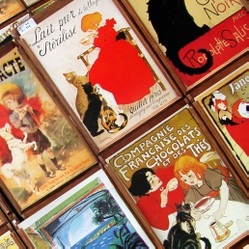I had been mulling over ideas for a new home business for several years. It had to be just right. I couldn't spare the time to deal with phone calls, pick-ups and deliveries, invoicing, and the constant search for customers that a graphics arts studio required. My business had to fit into a few hours a week, thrive with the simplest of office work and bookkeeping, fit into my home without disruption, and give me the maximum financial return for each hour invested. Most of all, since I was homeschooling, it could not take a lot of time away from my family.

My Ideal Home-Based Business
How I created an interesting, profitable home business to bring in extra income as a stay-at-home mom. By changing a few details, it could be just right for you too.
Searching for lessons
This is the story of how I created an interesting, profitable home business that was ideal for my life for a decade. By changing a few of the details, it could be a perfect idea for you too. The story begins when I was trying to find watercolor lessons for my thirteen-year-old daughter. Wouldn’t you think that would be easy? Well, I spent months asking around and tracking down leads. No one in our town of thirty thousand people was teaching children painting.
I told this to an artist acquaintance who was having financial problems. She desperately needed a way to earn some extra money. “It would be easy for you to teach painting classes,” I urged her. “You could find some library books to follow for a course structure, advertise on community bulletin boards, and teach in your home. There would be almost no expense.” What could be simpler?
She never pursued the idea, but I couldn’t quite forget it. Too bad I didn’t have fine art training. I had run a home business before, as a freelance graphic artist, and I had taught what was then known as commercial art (graphic design) in a community college years ago. But I wasn’t a painter.
The idea takes hold
Once day it occurred to me that even though I didn’t feel qualified to teach fine art, I was certainly qualified to teach commercial art. But, other than cartooning, commercial art was generally considered to be an adult pursuit, too technical for children. (Remember this was in the days before home computers were common.) But wait a minute. My high school had offered commercial art as a major and we loved it. Could I teach something similar but at an easier level? I could call it Commercial Art for Kids. It would be bright and colourful. It would be basic. It would certainly be varied, since the world of graphic design is very broad. And it would give kids a taste of the career world of commercial artists. But, would parents go for it?
What's the going rate?
I decided to work on a plan. I had a model in mind - my daughter’s sewing lessons. One hour
a week in a class of four, and the fee was almost ten dollars a class, plus materials. I signed up for the school year and paid by post-dated cheques when I registered, and was happy to do it. The bookkeeping on that would be easy and it sounded pretty close to forty dollars an hour to me.
My other point of reference was my other daughter’s ballet lessons. These took place in a
studio that was attached to the teacher’s home. Again the cost was close to ten dollars an hour, and the classes were from ten to twenty children. Additional charges were made for costumes and recital fees. There were lots of classes, so apparently many parents did not consider this too expensive. When I checked the cost of private piano lessons, in the teacher’s home, I learned that parents
were paying $13.50 to $15.00 for half an hour. I began to realize that putting their children in lessons is very important to parents and they are willing and happy to pay for it.
Working out a plan
What about running this business in our home? Our house had an almost finished walk-in basement. The available space was bright, clean and, so far, unused. The entry was directly from outside, no traffic through our living quarters. I wanted to focus on quality teaching, which to me means small
classes, so the space available was perfect. It just needed to be furnished.
Next question was lessons. I decided my year would follow the school year, but start a little
later and end a little earlier, about thirty-five weeks in all. The hour-long lessons would be after school. Since I’m serious about learning and about giving people true value for their money, I decided to set up a course of study that would progress from year-to-year, just like piano or ballet. My goal was, at least, to help kids improve their general art and design skills, and at best, to give them a major head start if they decided to study graphic arts in college. So I pulled out all the material I had from my own college courses, both those I took and those I taught, and studied it carefully to see how I could adapt it for the ten-year-old intellect. I began to formulate a plan for the structure of my course.
At this point, my husband and I came to the conclusion that teaching art lessons in our home
looked like a workable idea, and I should go ahead with it.
Setting up shop
We agreed to consider the first year an investment. If I covered my start-up costs, we would call it a success and start looking for an actual income the second year. For a surprising low price we found a u-shaped office unit with a hutch, a matching wide file cabinet and six drawing tables. We saved money by transporting and assembling everything ourselves. I also purchased hydraulic steno chairs, again, at a bargain price. My plan was to set up the studio as close to a professional workspace as possible, since this would be part of my teaching approach - imagining that we were real graphic artists working in the real world.
All this took place during the summer. I had previously looked into the bylaws and learned that a home business was legal in my zoning, as long as I did not sell retail, and did not have more than ten students at one time. So I purchased a business license and began to plan my advertising. I prepared a brochure and ran it off. I distributed these at the public library, the leisure center and to all the elementary schools through the school board office. I also took out a display ad in the community leisure magazine that advertised community clubs and programs of the recreation department. This was very inexpensive compared to newspaper advertising, and would be kept much longer. I did no newspaper advertising the first year.
Success on a shoestring budget
The phone calls began to come in, and when the dust settled in mid-September I had filled three
classes with a total of seventeen students. Since I had based my tuition fees on ten dollars an hour, this meant I was bringing in a gross amount of $170.00 per week. Of course, the first year that was eaten up by expenses, but in subsequent years, the furniture and equipment would be paid for and the cost to replenish my supplies would not be very high. The office work was simple since all I had to do was deposit post-dated cheques on the fifteenth of each month and keep track of expenses.
Well, my year was a success, and the impact on my family was minimal. (The worst hardship was
a no-television rule during class time, because of the way the sound travelled through our floor.) The next year I expanded to a level two and also added on a ten-week basic drawings skills course for the younger age-group. Again, I filled, three level one classes, plus a level two class, and two drawing skills classes. The third year I had nine classes running. This amounted to only nine hours a week plus preparation time, but if each class were filled to capacity, that would be $540.00 a week. Of course not every seat is filled, students do drop out, and income stops during the summer, but I had friends who worked at full-time jobs to earn that much money and they had to leave home to do it.
Income AND satisfaction
From start to finish, I ran my art school for a decade. During that time I renamed the school
Aspire Art and Design for Kids. I kept refining and expanding my course offerings. I brought in my son-in-law to teach a course on superhero comic book art (anatomy drawing – trust me). The enrollments grew every year. I brought three more drawing tables and increased my class size to nine. I met a lot of great kids, saw them create a lot of great art, and enjoyed myself thoroughly while I made a very decent income. And my time investment was still less than fifteen hours a week.
For me, for that decade of my life, I had found the ideal home business.
What is your skill, hobby or specialized knowledge?
Could you use it to train other people?
Maybe you have been overlooking the income possibilities of your expertise. A foreign language, computer skills, cooking, outdoorsmanship? People will sign up for lessons. What can you teach them?
Remember, the real profit is in teaching classes, not individuals. You charge less than for private lessons, but bring in a much higher rate per hour of your time.
Here are some idea starters:
- Carpentry
- Ceramics
- Classic games - chess, backgammon
- Computer Skills
- Cooking
- Crafts
- Creative Writing
- Dance
- Drama
- Drawing
- Fitness
- Foreign Languages
- Gardening
- Knitting and needlework
- Music - voice, instrument
- Naturalist
- Outdoorsmanship
- Painting
- Science experiments
- Sewing
- Sport Skills
- Swimming
You might also like
Earning Money Online - How's it going?This is my Wizzley earnings page. I'll share information about how much money...
Working From Home is My Dream Come TrueAfter many years of working out in the world and making little money, I now h...



 Help Me Sleepon 02/17/2012
Help Me Sleepon 02/17/2012
 How to Get to Sleep More Easilyon 02/16/2012
How to Get to Sleep More Easilyon 02/16/2012
 How to Get a Better Sleepon 02/12/2012
How to Get a Better Sleepon 02/12/2012
 The BEST Non-Stick Frying Panon 01/14/2012
The BEST Non-Stick Frying Panon 01/14/2012


Your Thoughts
I have often thought of teaching writing workshops to other homeschoolers. Your story is inspiring. (wish there were some photos of the studio!)
What a great story. My 5 year old son is very interested in art, I'm sure he would love a course like that. I'm enjoying working online to earn money, much more flexible than a proper job!